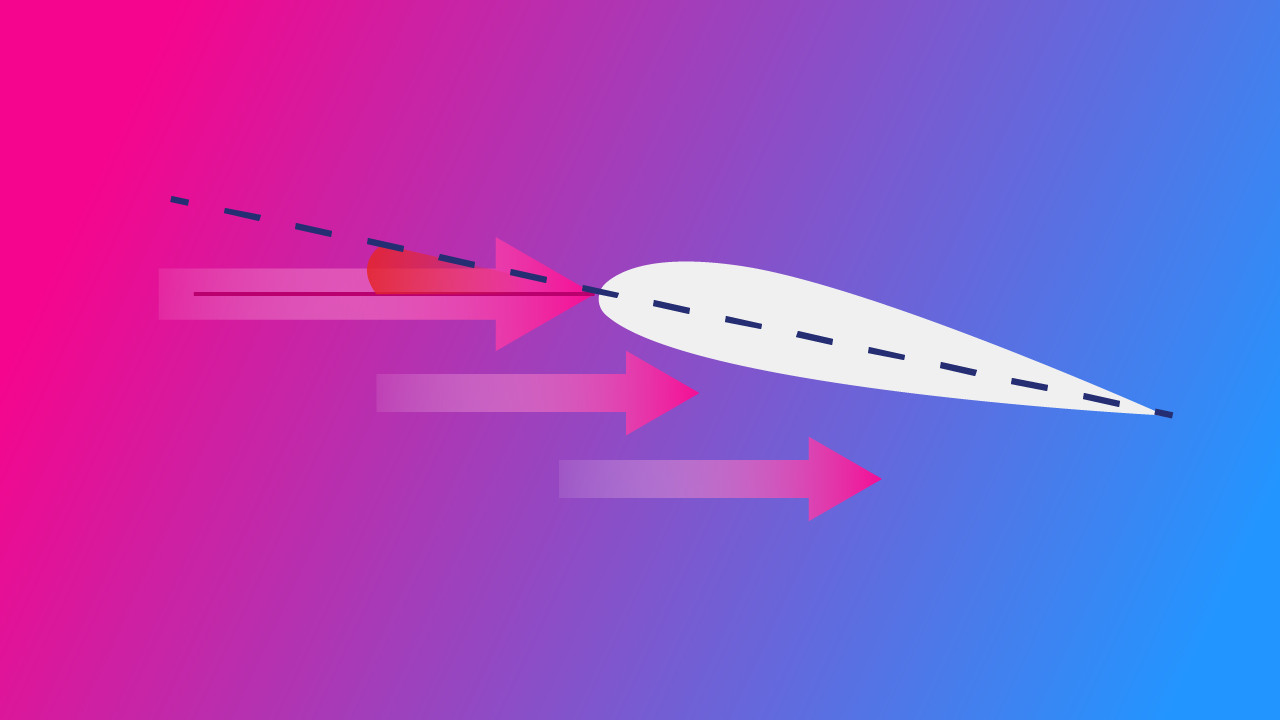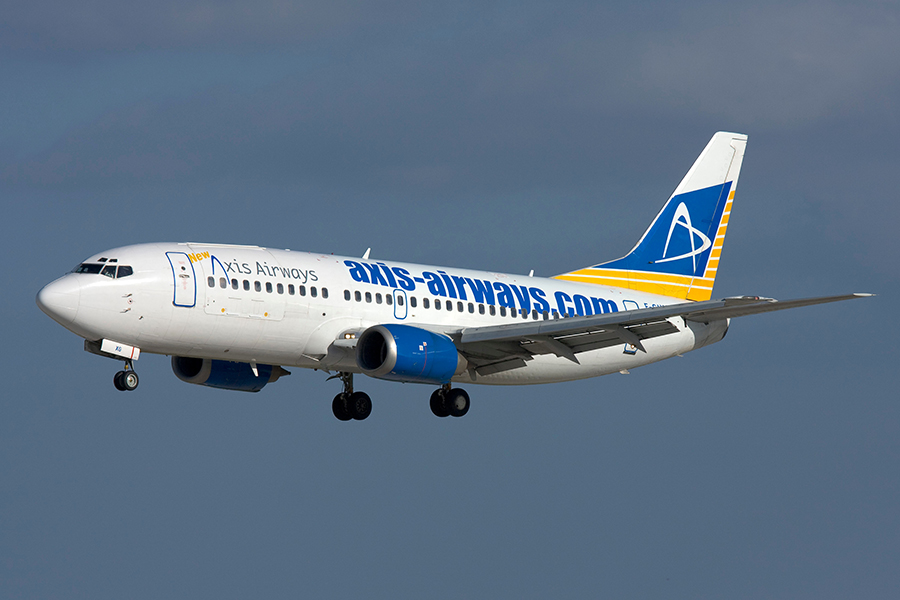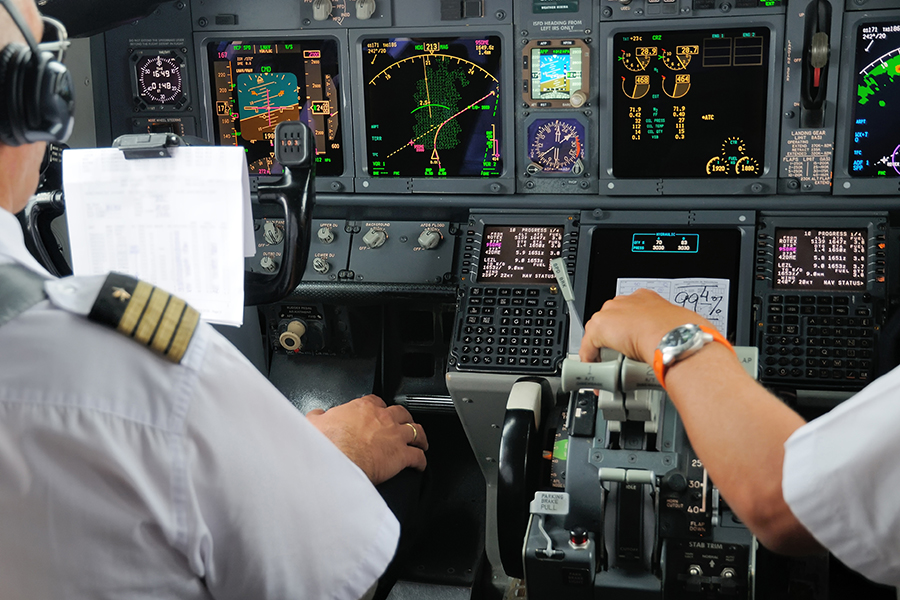-
Key Takeaways
-
What Is the Angle of Attack?
-
How Does the Angle of Attack Work?
- What Is Relative Wind?
- What Is the Coefficient of Lift?
- How Can Managing AOA Improve Your Flight?
- Slow Flight and Angle of Attack
-
Why Does Angle of Attack Matter?
- Stall Awareness
- Steep Turns
-
The Angle of Attack Vs. Pitch – Are They the Same Thing?
-
Factors That Affect Angle of Attack
- Wing Size and Shape
- Ice
- Wing Contamination
- Load Factor
- Weight
- Configuration Changes
- External Forces
-
What Is the Critical Angle of Attack?
- Stretching the Glide and Exceeding Critical AoA
- How Does an Aircraft Warn Pilots About Approaching Critical AOA?
- Angle of Attack Safety Concerns
-
How Do Pilots Monitor Angle of Attack?
- AOA Indicators Improve Safety
-
Conclusion
The art of flying is a delicate balance where the laws of aerodynamics come into play. And at the heart of it all lies the Angle of Attack (AOA). This fundamental skill improves safety and also allows for precise control during flight.
Are you ready to unlock the secrets behind this aerodynamic concept? Let’s begin!
Key Takeaways
- The angle of attack (AOA) is the angle between an aircraft’s wing chord line and the relative wind.
- Proper AOA management affects lift generation and stall prevention.
- Every aircraft has a critical angle of attack, where the wing will stall.
- Modern AOA indicators help pilots maintain safe flight attitudes and prevent stalls.
What Is the Angle of Attack?
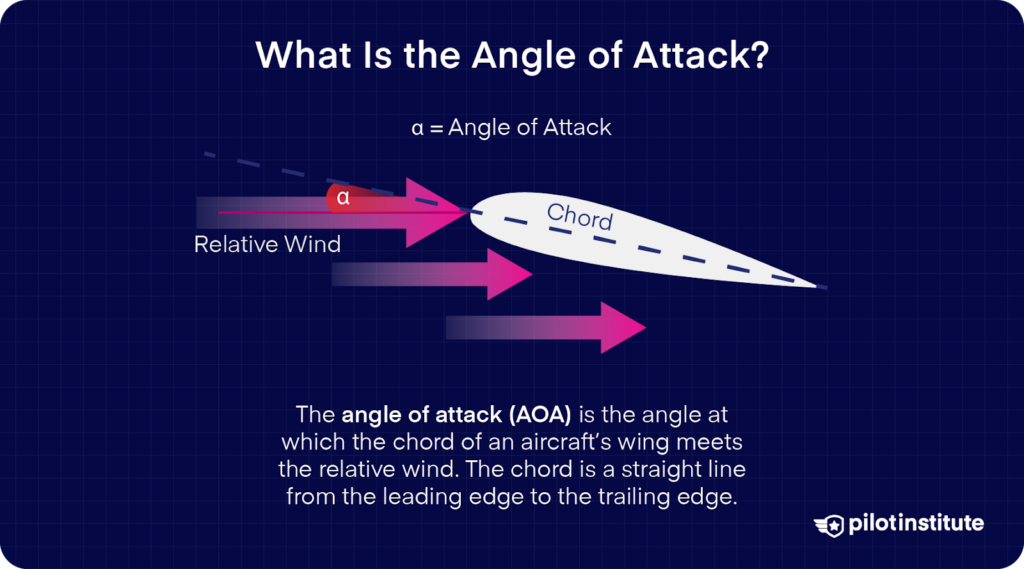
The angle of attack is the angle at which the oncoming airflow meets the wing. It is measured using the wing’s ‘chord line,’ a straight line drawn from its leading edge to the trailing edge. The angle of attack is independent of pitch attitude, and many factors affect it.
How important is the angle of attack?
Well, the angle of attack influences the aircraft’s behavior on a fundamental level. It is one of the main factors affecting lift, and airplanes need a constant source of lift to fly.
Here’s what you need to know.
How Does the Angle of Attack Work?
As we’ve already stated, the angle of attack is the angle formed between the aircraft wing and the oncoming airflow.
You’ll see it written in a few ways:
- Angle of Attack
- AoA
- Alpha
- α
Regardless of how it is written, the above all relate to the same thing.
When viewed in cross-section, wings are curved—ever tried to measure an angle from a curved surface? Kind of tricky, right?
For this reason, aircraft theorists use something called the chord line. You can read more about chord lines here.
But if you want a quick recap, the chord line is a straight line intersecting the wing. It runs from the trailing edge through to the leading edge. This forms an ideal (and straight) datum, allowing us to measure the angle of attack.
When an aircraft moves forward, the air produces a resultant force. This resultant force is called relative airflow.
The angle of attack is the angular difference between the relative airflow and the wing’s chord line.
Want two really simple general rules explaining how the angle of attack works?
- A greater angle between the chord line and the relative airflow means a higher angle of attack.
- A lower angle between the chord line and the relative airflow means a lower angle of attack.
Relatively easy so far?
In practice, it can be a little more complex.
As we stated a little while ago, understanding the angle of attack is fundamental to understanding aerodynamics and how lift is generated.
What Is Relative Wind?
The relative wind is the direction of the air moving over your wing. It is parallel to the aircraft’s flight path. A basic knowledge of relative wind is required because it’s important for calculating the AOA.
What Is the Coefficient of Lift?
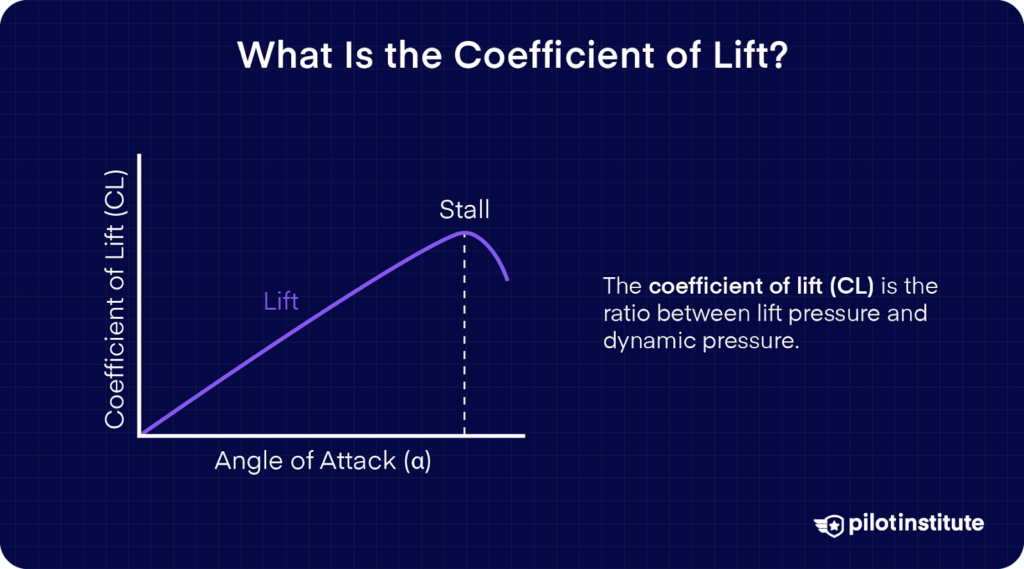
When discussing the angle of attack, we are most concerned with the coefficient of lift (CL).
The coefficient of lift is a function of the angle of attack.
The coefficient of lift (CL) measures how a wing generates lift at a specific AOA. As the AOA increases, the CL also increases, but up to a certain limit, known as the stall angle.
Once this limit is exceeded, the CL decreases as the wing begins to lose lift and experiences a stall.
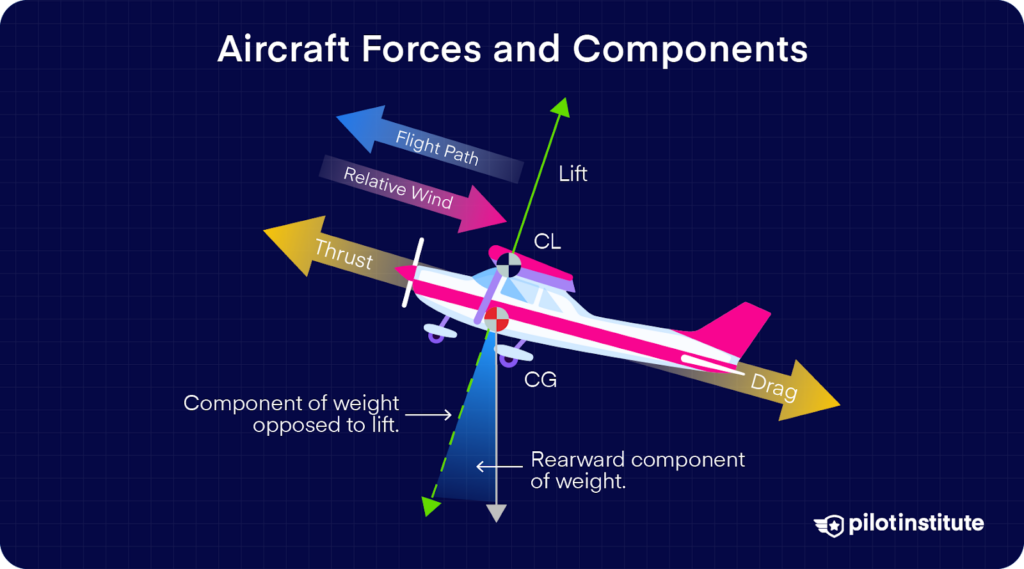
How Can Managing AOA Improve Your Flight?
Managing the angle of attack matters because it directly influences lift generation and drag in all phases of flight. This is especially true during steep turns, engine-out scenarios, and power-on or power-off stalls.
Proper angle of attack management also maintains safety during slow flight, crosswind landings, and when encountering wake turbulence.
Proper AOA management can improve the aircraft’s fuel efficiency, help climb rates, and reduce the risk of stalls.
Slow Flight and Angle of Attack
During slow flight, managing the angle of attack becomes essential. At lower speeds, the aircraft needs a higher AOA to generate enough lift, which brings it closer to the critical AOA.
Slow flight is a fundamental part of flight training. Your instructor will teach you how to safely fly the airplane at low speeds and a high AOA. You will also develop a feel of how the aircraft feels as it approaches a stall.
Remember: If we reduce the speed, we must increase the angle of attack to compensate. Again, by increasing the angle of attack, we come closer to the critical angle.
Why Does Angle of Attack Matter?
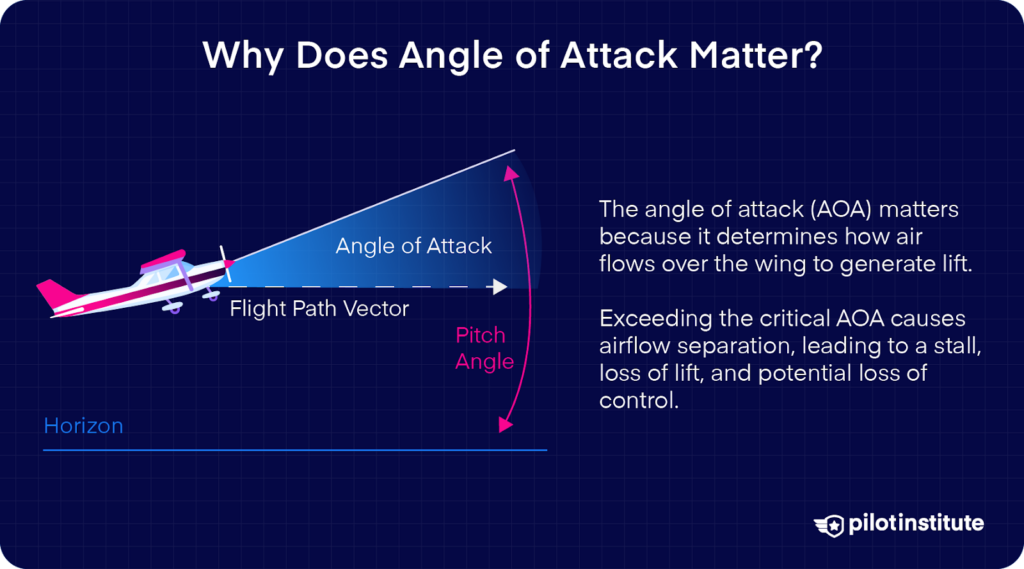
AOA influences every aspect of your flight. It’s the key factor that determines how much lift the aircraft wing generates. As you increase your AOA, lift goes up—but only to a certain limit. After that point, lift will go down.
Stall Awareness
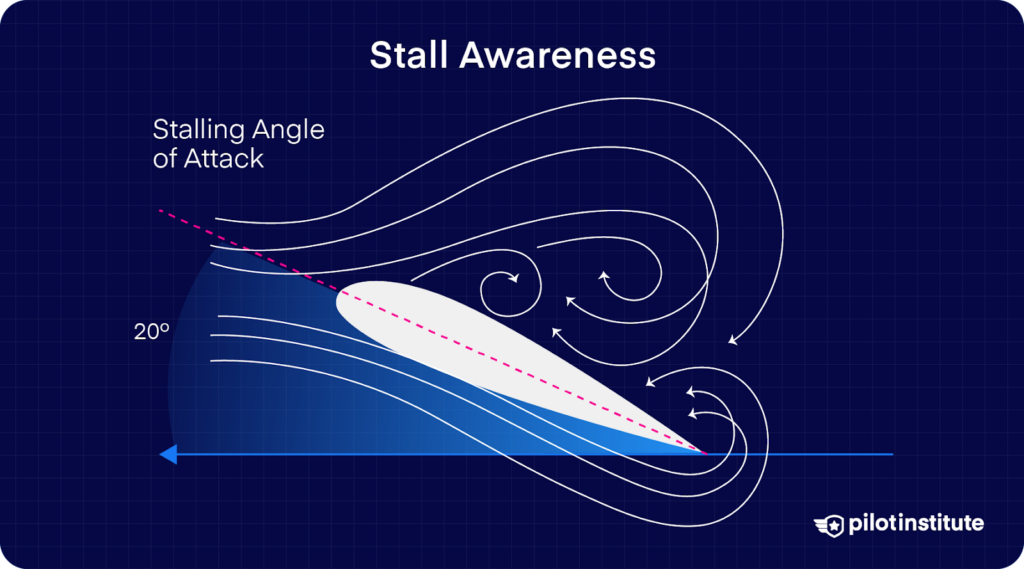
By now, it should be obvious. There are limits to how much you can increase α before you reach the critical angle of attack.
Remember, the aircraft will always stall at a set α value for a given configuration, regardless of attitude or speed.
Steep Turns
During the steep turns, there is an effect that makes reaching a high angle of attack much more likely.
As you ‘pull’ the aircraft around the turn, you create a gravitational effect. Ever noticed your arms and legs feel ‘heavy’ when making steep maneuvers? Essentially, you are increasing the gravitational force on the aircraft.
And here’s the thing.
Let’s say you pull 2 G’s. During the maneuver, the aircraft (and everything in it) weighs twice as much. This means the wing has to work doubly hard to produce enough lift to maintain level flight. To counter the effect of this wing loading, the pilot has to pull on the stick.
You’ve guessed it! Pulling on the stick increases alpha, bringing you closer to the critical angle.
The Angle of Attack Vs. Pitch – Are They the Same Thing?
It is important to note that, while they can be related, aircraft pitch attitude is not the same as the angle of attack. The angle of attack is a relationship between the chord line and the oncoming airflow. Pitch attitude is the relationship between the aircraft nose and the horizon.
It might seem like we are dealing with semantics, but you must understand this concept.
Here’s why.
Let’s say you dive the aircraft down at a 45° angle towards the ground (from a safe altitude) before hauling back sharply on the control column.
Your pitch attitude is -45° during the early stages of the maneuver.
A low-pitch attitude means a low angle of attack, far away from our critical angle, right?
Nope!
Once the aircraft is stabilized in its dive, your pitch attitude is true -45°. However, that is regarding the earth’s horizon.
The angle of attack, formed between the wing chord line and oncoming airflow, will be much closer to somewhere around 3°.
To make life easy, let’s say the critical angle of attack (where the wing will stall) is 15°.
When you haul back on the control column, even though your pitch attitude is well below 15°, your angle of attack isn’t… meaning it won’t take much to exceed the critical angle. Many pilots have stalled in a dive.
In fact, you should remember this simple rule:
- An airplane can stall at any altitude or airspeed if the critical angle of attack is reached.
Inverted, in a climb, a dive, wings level… It doesn’t matter. If the angle of attack exceeds a given value, you will stall the aircraft.
It is also possible to stall at high speed. Stalls tend to happen at slower speeds because the aircraft’s angle of attack is already high to ensure enough lift is produced to keep the aircraft flying.
This leads to a high-nose attitude, which is why many incorrectly assume that high pitch and high angle of attack are always the same.
Factors That Affect Angle of Attack
Let’s take a look at the factors that influence the AOA during flight:
Wing Size and Shape
As a general rule, the larger the wing, the more lift it produces.
However, size isn’t everything.
The wing shape is just as important regarding the angle of attack.
Different wings offer a different lift-to-drag ratio. Some are designed to be benign in handling, whereas others (such as fighter aircraft wings) are designed to be inherently unstable.
Ice
There is one situation where nobody can guess what the critical angle of attack will be.
We are talking about icing.
Ice causes problems for two reasons when it comes to the angle of attack.
First, ice changes the shape of the wing and severely affects aerodynamics.
Second, even a small layer of ice can weigh a substantial amount.
It’s pretty bad.
More weight and an ‘experimental’ wing mean that the angle of attack is severely and unpredictably altered.
Wing Contamination
While not quite as severe as ice, other contaminants can affect the angle of attack. Clean wings are the most efficient. Dust, bird droppings, or general dirt all reduce this efficiency. This can lead to a change in the critical angle.
Load Factor
Load factor, while related to aircraft weight, is not the same thing.
Load factor is the apparent change to weight caused by ‘pulling G’.
And it can get a little dangerous when it comes to AoA.
Here’s why.
The stall speed (used by airplane manufacturers to give you a good idea of when you are reaching critical alpha) increases at the square root of the load factor.
Let’s say your stall speed was 60 knots. When pulling two G’s, you’ll find this increase by about 1.4!
60 X 1.4 = a new stall speed of 84 knots! Meaning the critical alpha is reached sooner!
Weight
For an aircraft to maintain a level altitude, the lift produced must equal the aircraft’s weight.
If we increase the weight, then we also must increase the lift.
Make sense so far?
There are only two ways to increase the lift (and again, it relates to our equation above)…
Either we fly faster, or we increase the angle of attack.
Increasing speed isn’t always possible, and you’ll tend to find that at higher weights, the aircraft pitch attitude is higher. A higher pitch attitude generally means a higher angle of attack in level flight.
Configuration Changes
While flaps and power settings don’t directly change the AOA, they affect how lift is produced. Flaps allow the aircraft to generate the same amount of lift at a lower AOA.
Power settings can affect the pitch attitude needed to maintain a specific AOA.
External Forces
Factors like turbulence, wind gusts, and wake turbulence can lead to sudden fluctuations in AOA. Quick and precise corrections are needed to maintain safe flight in such conditions.
What Is the Critical Angle of Attack?
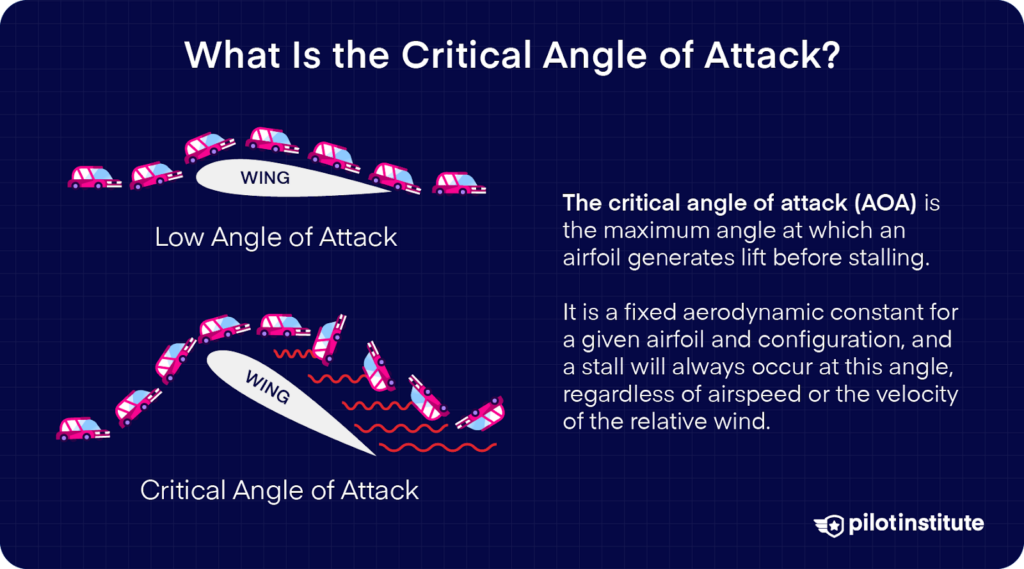
Every wing has a critical AOA, the point at which smooth airflow disrupts, resulting in a loss of lift and a stall. The critical AOA depends on the wing design. For many general aviation aircraft, the critical AOA is in the range of 15-18 degrees.
Stretching the Glide and Exceeding Critical AoA
While engine failures are exceptionally rare, they do happen. Often pilots exceed the critical angle of attack while trying to ‘stretch the glide’ and reach a landing site.
It is imperative that if you are gliding an aircraft, you don’t pull back to try and extend the aircraft’s engine out of range. Maintain your best glide speed, representing the optimum between lift and drag.
How Does an Aircraft Warn Pilots About Approaching Critical AOA?
Most aircraft have stall warning systems that notify you before reaching the critical AOA. In aircraft without built-in systems, pilots must rely on AOA indicators or situational awareness to avoid exceeding this angle.
Some common signs of an imminent stall include:
- Buffeting.
- Hearing a stall horn.
- Mushy controls.
Angle of Attack Safety Concerns
Can you exceed the critical AOA without realizing it? Absolutely! And here’s why:
While the critical AOA is primarily determined by wing design, certain conditions, such as ice accumulation on the wing or compressibility at higher speeds, can change the critical AOA.
But, certain flight conditions make it easier to reach this dangerous angle.
For example:
- When an aircraft is heavier, it requires a higher AOA to maintain level flight.
- Increased load factor during turns requires higher AOA to maintain altitude.
- Turbulent conditions can suddenly change your AOA.
How Do Pilots Monitor Angle of Attack?
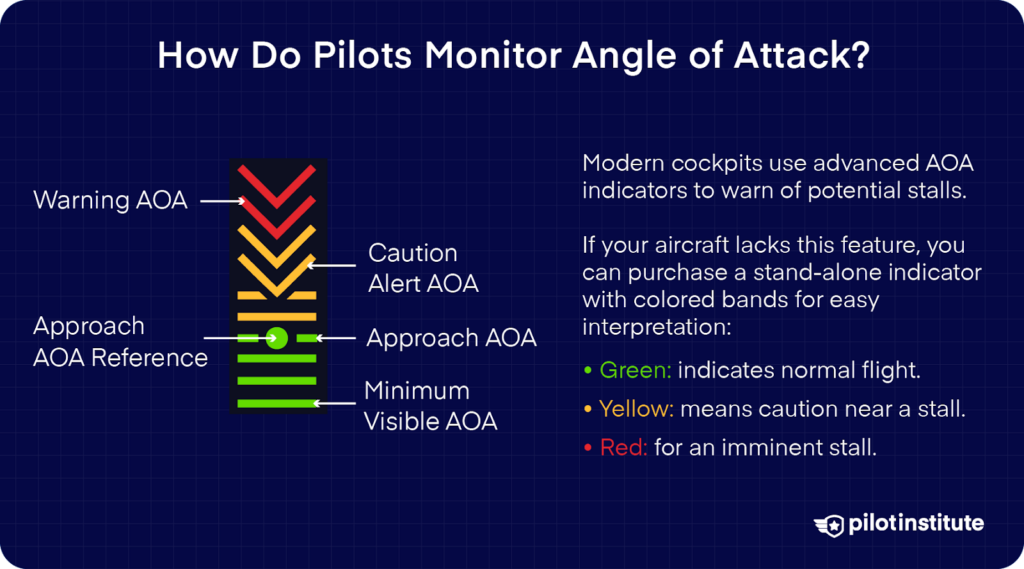
Today’s cockpits are equipped with advanced AOA indicators that can let you know when a stall may occur. These indicators are made to provide reliable information about the airflow over the wing.
What should you do if your aircraft doesn’t have an AOA indicator? If your aircraft doesn’t have one, you can purchase a stand-alone AOA indicator, which uses simple colored bands:
- Green indicates normal flight.
- Yellow means caution near a stall.
- Red for an imminent stall.
Digital AOA displays can present values using colors and symbols such as chevrons for easy interpretation. Some AOA indicators also provide audible alerts when your aircraft nears the critical AOA.
AOA Indicators Improve Safety
Many pilots view AOA indicators as reliable safety tools, as they offer quick and immediate information.
What are some other benefits? AOA indicators are particularly useful during takeoff and landings, where maintaining precise control of the AOA is required.
Conclusion
While the angle of attack, or alpha if you prefer, is simply the angular difference between the chord line and airflow, there is actually a lot to think about. If you want to learn more about aerodynamics and piloting, check out our free pilot course for other great lessons.
